
In Bootle’s aged shopping centre, billboards promise “there’s something changing at the Strand” but the place feels haunted by the past. The butcher’s shop where two-year-old James Bulger was abducted is long gone, as is the Mothercare where dozens of anxious parents bought 60s-style reins in the days after he was taken.
On the lower level, where CCTV cameras captured that haunting image of James being led away by one of his killers, a giant black poster celebrates 50 years of the Strand. It has been here since 2018. Even the big clock at the bus station next door is stuck in the past.
“I wouldn’t even say 50% of the shops are open now,” said Dave Allen, 52, clutching the hand of his four-year-old grandson on their way into Poundstretcher. “There was a lot more shops back then.” Allen, from nearby Kirkdale, is thinking back to 1993. Nobody around here can forget.
The Strand was filled with Friday afternoon shoppers when, 30 years ago on Sunday, James was beckoned from his mother’s side by two 10-year-old boys who marched him two-and-a-half miles to a railway line where they bludgeoned him to death. It remains one of Britain’s most shocking, and far-reaching, crimes of the last century.
“It’s still in everyone’s mind. How can it not be?” Allen asked. His daughter was a similar age to James in 1993 and the memory has passed down generations like a haunted heirloom. “My eldest, his mum, is very protective of him,” he said, gesturing to his grandson. “Especially when we’re here. It’s that long ago but you just can’t help it.”
Thirty years later, the details are as familiar as they are horrific. The toddler with bouncy blond hair had let go of his mother’s hand for only seconds when he was lured away by two truanting classmates, Jon Venables and Robert Thompson.
In 91 seconds, they had spirited him out of the Strand and begun the long walk across Bootle and Walton to a railway line where they had a den on the embankment. They were seen by 38 people, most of whom did nothing, perhaps believing, understandably, that no horror could be committed by such young boys. Some thought James was their little brother.
At the railway line, they bludgeoned him with weapons including a 22lb iron bar then left the toddler, wearing his Noddy t-shirt, to his death on the tracks.
Venables and Thompson, both now 40, remain the youngest people to stand trial for murder in the UK. The pair have new identities but only Thompson has remained out of custody since their release in 2001.
Venables has twice been convicted for possessing child abuse images, most recently in 2017 when he was found with a “paedophile manual” and more than 1,100 unlawful photos or videos, a third in the most serious category. Some showed the sexual abuse of male toddlers. He was refused parole in 2020 but is awaiting a new hearing in spring.
The prospect of Venables’ release is a daily nightmare for James’s family, said Robin Makin, the solicitor for the boy’s father, Ralph Bulger, and his uncle Jimmy Bulger. “We are really concerned,” he said in a Liverpool cafe last week. “As far as Ralph and Jimmy are concerned, he is a real danger.” Makin, who has represented Ralph since his divorce from James’s mother, Denise Fergus, shortly after the murder, said the father had been “completely let down” by the Ministry of Justice.
Thirty years on, it is difficult to find anyone satisfied with the judicial and political response to the killing. Fergus, 55, believes Venables should never be let out of prison. “Thirty years does seem like yesterday, the wounds don’t ever heal when you have buried a child, but they certainly can never do so when one of the murderers responsible persists in reoffending and then continues to bid for freedom,” she wrote in new chapters of her memoir, I Let Him Go, published to mark the 30th anniversary.
Venables and Thompson were originally recommended by the trial judge to spend eight years in secure children’s homes for the crime he called “an act of unparalleled evil and barbarity”. The then home secretary, Michael Howard, increased their tariffs to 15 years, egged on by a 270,000-strong petition in the Sun newspaper demanding life sentences. But that was quashed by the court of appeal which ruled he had given too much weight to the Sun’s campaign.
In the fevered atmosphere after the murder, the then prime minister, John Major, said society should “condemn a little more, understand a little less” when it came to youth offending. Howard, when he became home secretary, said “we must take the thugs off the streets”. The tabloids were venomous. “Freaks of Nature”, shouted one front page. “How Do You Feel Now, You Little Bastards?” screamed another.
Speaking to the Guardian for this article, Howard said he had no regrets over his handling of the case. People were “absolutely horrified”, he said, that “such an unspeakable crime could have taken place in our country and that the perpetrators were so young”: “It was all unthinkable. It was beyond what anybody thought could happen in late 20th century Britain.”
It took place against a backdrop of concern about a general social decline in the early 90s. Violence and criminal damage had almost doubled since 1983, robberies had nearly tripled, sexual offences were up by 50% while total recorded crime had risen by 70% compared to a decade earlier.
The then shadow home secretary, Tony Blair, vowed to be “tough on crime, tough on the causes of crime” as both main parties jostled for a more punitive approach. In 1998, the new Labour government abolished an important legal principle that protected children aged 10 to 14 from being criminalised. Four years later, Blair introduced new police targets that caused a huge increase in the number of young people in trouble with the law for the first time, peaking at 110,784 in 2006/7. It has since fallen sharply and today stands at just over 8,000, of whom 320 are aged 10 to 12. England, Wales and Northern Ireland remain some of the only nations in the western world to criminalise children under 12.
“It was a catalyst for bringing in more punitive responses [towards children],” said said Deena Haydon, a children’s rights researcher who co-authored a paper on the impact of the Bulger case. “Anti-social behaviour orders, parenting orders, curfew orders – civil orders which became criminal offences if breached.”
Ross Little, a criminologist and trustee at the National Association for Youth Justice, said the UK had become an “international outlier” in its approach to children. “It’s an emotive case and I don’t think we can base our law on one case,” he said. “I think it would be good if after 30 years, we can take this step back a little bit, recognise that it was a terrible, tragic case, but perhaps it’s time for a slightly wider debate in relation to how we treat children in the criminal justice system.”
David Blunkett was Labour’s home secretary when Venables and Thompson were released from secure accommodation in 2001, aged 18. There was, and still is, serious concern about “wild west” vigilante attacks against them, he said. Even writing about the case 30 years on is “like throwing a match into a petrol can”.
After the killing, Blunkett, then shadow health minister, took aim at the “paternalistic and well-meaning indulgence” of professionals who tolerated “the sub-culture of thuggery, noise, nuisance, and anti-social behaviour often linked to drug abuse”. Today he is more phlegmatic. “We obviously were dealing with incredible sensitivities, and people were so shocked and horrified at the time,” he said.
Would society, politicians and the judiciary respond differently if a similar crime happened today? “I think that we would have a different view about the long-term implications for those two young men and how to stop them getting themselves into a situation later in life where they would be once again involved in the criminal justice system.”
In a crisp corner of Liverpool, three miles from the Strand, two white marble angels guard the spot where James was buried with his favourite teddy, a toy motorbike, and a torch on 1 March 1993, 15 days before his third birthday. A ninja turtle figurine clings to the tree marked “James’s special place”, which does its best to protect his pristine grave from the elements. This year, like every anniversary, James’s mother will return here to remember her late son. Not that she, or the nation, can forget.












